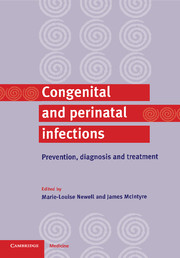Book contents
1 - Infections in pregnancy: introduction
Published online by Cambridge University Press: 06 July 2010
Summary
Introduction
Infections in pregnancy that can be transmitted from mother to child are of particular concern since congenital or perinatal infections may be associated with adverse sequelae. Maternal infections that have the potential of infecting the fetus or newborn infant are listed in Table 1.1 and include viral, bacterial and protozoal infections. The consequences and management of individual infections are discussed in detail elsewhere in this book. The purpose of the present chapter is to present an overview of the salient features and issues that arise in relation to the detection and management of infections in pregnancy, largely from a population perspective. This epidemiological knowledge is needed to establish a causal relationship between an infection and the outcome, to inform decisions about screening in pregnancy and also to ensure the most appropriate management of a woman with a specific diagnosed infection in pregnancy.
All the infections listed in Table 1.1 can cause fetal or perinatal infection, sometimes associated with an adverse outcome such as fetal loss, stillbirth, prematurity, fetal damage, or acute neonatal infection. For some congenital infections there may be no evidence of symptoms or signs of infection in the neonatal period and it may be weeks, months or even years before damage first becomes apparent (Table 1.2).
Mode of acquisition of infection
The route by which the fetus or newborn acquires the infection has important implications for the management of the infection in pregnancy, or in the neonatal period, and for the development of appropriate intervention programmes to prevent mother-to-child transmission. Infections of the newborn maybe acquired in utero (congenital infection), around the time of delivery (intrapartum infection) or in the neonatal period (postpartum infection) (Table 1.3).
- Type
- Chapter
- Information
- Congenital and Perinatal InfectionsPrevention, Diagnosis and Treatment, pp. 3 - 14Publisher: Cambridge University PressPrint publication year: 2000



